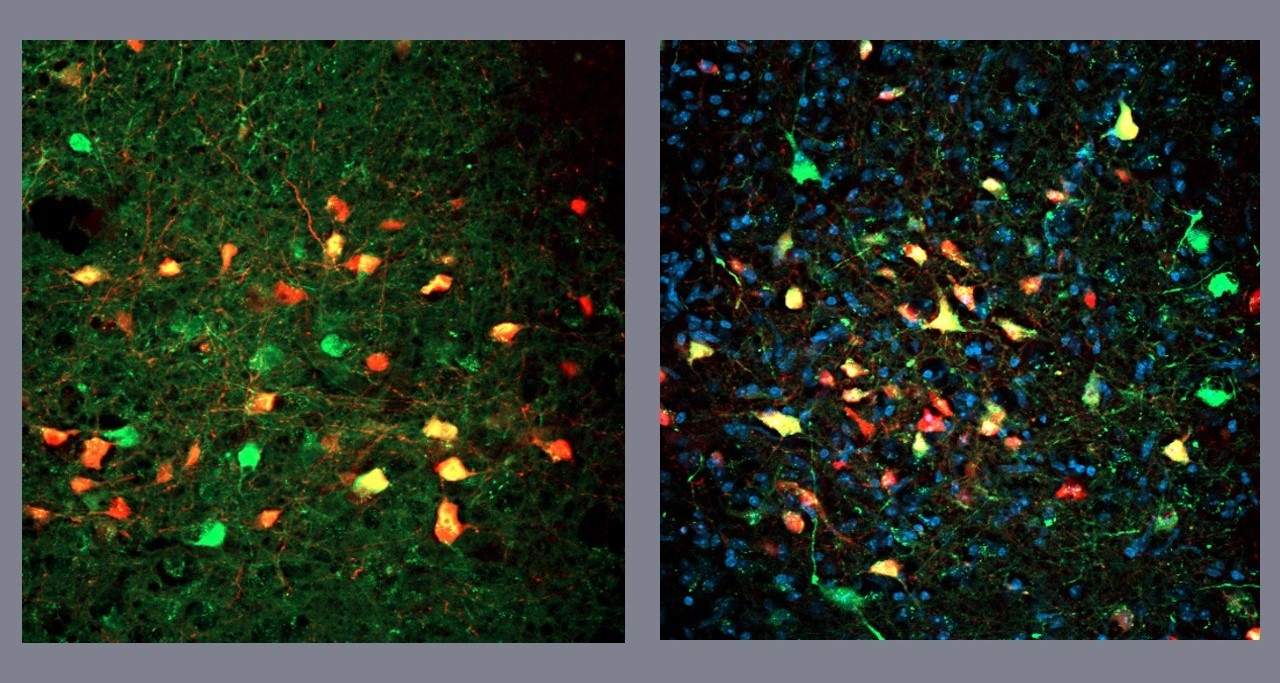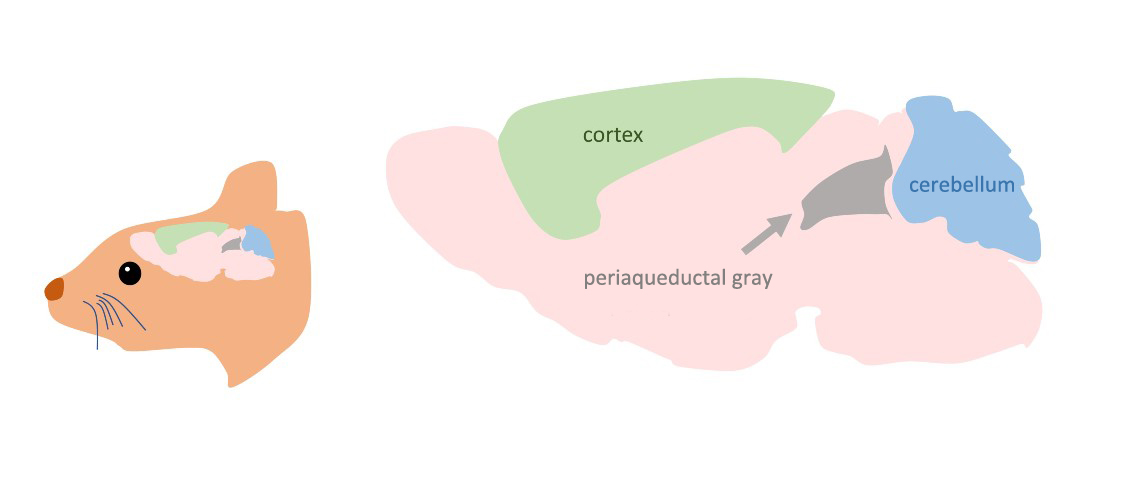

VGAT cells in the periaqueductal gray, stained green and yellow. The cells stained red make synaptic contacts in VGAT neurons (images: researchers’ archive)
In a study involving mice, scientists used a technique that combines light stimulation and bioengineering to activate a cluster of nerve cells deep inside the brain. The discovery could pave the way to future treatment of eating disorders.
In a study involving mice, scientists used a technique that combines light stimulation and bioengineering to activate a cluster of nerve cells deep inside the brain. The discovery could pave the way to future treatment of eating disorders.

VGAT cells in the periaqueductal gray, stained green and yellow. The cells stained red make synaptic contacts in VGAT neurons (images: researchers’ archive)
By Mônica Tarantino | Agência FAPESP – For the first time, researchers have identified a group of neurons deep in the brain that are associated directly with compulsive eating and food craving. The discovery is reported in an article published in Nature Communications by researchers at the University of California, Los Angeles (UCLA) in the United States and the Federal University of the ABC (UFABC) in São Bernardo do Campo, São Paulo state (Brazil).
The neurons are located in the periaqueductal gray, a region of the midbrain at the top of the brainstem, and are known as vesicular GABA transporter cells, or VGAT cells for short. They use the neurotransmitter GABA (gamma-aminobutyric acid), which plays an important role in the regulation of neuronal activity. They are present in several parts of the brain and spinal cord, contributing to the modulation of mood, sleep, anxiety and response to stress, among other functions.
“However, nothing was known about the link between VGAT cells in the periaqueductal gray and feeding,” said Avishek Adhikari, a professor in UCLA’s Department of Psychology and head of its neuroscience lab, which focuses on how the brain coordinates the constellation of changes relating to aversive emotions such as fear and panic.

The discovery was accidental. “We were interested in anxiety rather than feeding when we began investigating the neurons of the periaqueductal gray,” said Brazilian neuroscientist Fernando Reis, first and corresponding author of the article, and a postdoctoral fellow at UCLA.
FAPESP supported the research via three projects (16/17329-3, 19/17677-0 and 19/17892-8).
The researchers’ initial hypothesis was that activation of VGAT cells should inhibit fear and panic reactions. “When we activated them in mice, that didn’t happen, but the mice began frantically looking for food,” Reis said.
He decided to conduct further experiments, which produced surprising results. Even in completely sated mice that should not have felt hungry, activation of the cells in question triggered vigorous foraging behavior and led them to eat more than usual. The opposite also happened. Mice deliberately left without food in order to make them hungry ate less when their VGAT neurons were inhibited.

During the tests, the scientists noticed that the mice appeared to enjoy the stimulation they received. “They spent longer on the side of the box where they received stimulation to activate their periaqueductal VGAT cells. We believe the compulsive foraging produced positive sensations associated with pleasure and reward,” Reis said.
The mice were also willing to surmount obstacles in order to seek food. “To reach titbits such as walnuts, they climbed a small wire mesh ladder that delivered low-voltage electrical shocks. That couldn’t have been pleasant, but the urge to feed and receive a reward was stronger than the discomfort,” Adhikari said.
Light stimulation
The neural circuit stimulated by the researchers corresponds to 10%-12% of the nerve cells in the periaqueductal gray. They used optogenetics to activate the neuron cluster selectively. “In our case, the problem optogenetics aims to solve is how to manipulate the activity of a subgroup of cells in a specific area of the brain,” said Adhikari, who trained as a postdoc at the Stanford University lab in the United States where the technique was developed.
The researchers used optogenetics to make the neurons sensitive to light so that they could be stimulated or inhibited. They did so by injecting into the mice’s brains a genetically modified virus carrying a light-sensitive protein obtained from green algae. “The selected neuron population infected with the modified virus receives this photosensitive protein together with instructions to produce it,” said Alexandre Kihara, a professor at UFABC and one of five Brazilians in the team of researchers who discovered the link between this subgroup of VGAT cells and food.
Fiber-optic cannulas were implanted in the mice to deliver blue light to the infected cells. “The light stimulus is captured by the photosensitive protein and converted into electrical activity. Cells are made more or less active according to the wavelength of the light emitted,” said Juliane Ikebara, a co-author of the article. She was supported by FAPESP as a PhD candidate at UFABC during the study.
The mice’s behavior changed drastically in response to the blue light. “We saw well-fed, sated animals charge off in hot pursuit of insects to devour,” Adikhari said.
Mapping of the neural networks involved showed that the increase in GABA affected areas deep inside the brain, such as the zona incerta, a thin layer of gray matter below the thalamus. “We observed an increase in neural activity in this area when the mice were approaching food,” he said.
The most important question is whether stimulation of the same brain region triggers compulsive eating in humans. Like mice, humans also possess VGAT periaqueductal gray cells in the brainstem, previous research has shown. Subjecting the region to a mild electrical current triggers symptoms of fear, panic and analgesia in both humans and rodents. The researchers believe a person might feel more rewarded by eating or crave more food even on a full stomach if this circuit is overactive, and vice-versa.
“Our findings can’t be directly tested in humans right now, but future studies may show whether activation of VGAT periaqueductal gray cells in monkeys triggers a search for food, suggesting that something similar happens in humans,” Adhikari said.
The group has embarked on new studies to investigate whether neuron stimulation induces a craving for protein- or sugar-rich food, among other aspects. “The mice weren’t interested in vegetables. They preferred sausages, sugar, cheese and chocolate,” he said.
For the researchers, the discovery that stimulation or inhibition of this specific brain region causes similar behavior to that seen in binge eating or anorexia could lead to the exploration of novel approaches to eating disorders.
The article “Control of feeding by a bottom-up midbrain-subthalamic pathway” is at: www.nature.com/articles/s41467-024-46430-5.
Republish
The Agency FAPESP licenses news via Creative Commons (CC-BY-NC-ND) so that they can be republished free of charge and in a simple way by other digital or printed vehicles. Agência FAPESP must be credited as the source of the content being republished and the name of the reporter (if any) must be attributed. Using the HMTL button below allows compliance with these rules, detailed in Digital Republishing Policy FAPESP.





